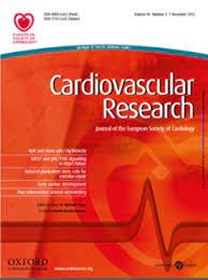HistAAA研究表明,腹主动脉瘤组织形态学在患者中显示出不同的炎症方面,与经典的危险因素无关
IF 10.2
1区 医学
Q1 CARDIAC & CARDIOVASCULAR SYSTEMS
引用次数: 0
摘要
摘要目的腹主动脉瘤(AAA)的治疗是在一个直径阈值。迄今为止,废除医疗增长的尝试都失败了。本研究旨在阐明AAA组织形态学的异质性与个体患者和动脉瘤指标的关系。方法和结果对左前动脉瘤壁标本进行组织学分析,包括血管生成、钙化、纤维化、外膜和中膜炎症的类型和等级。检索动脉瘤的临床信息和状态(完整、有症状、破裂、炎症)。包括半自动几何分析(Endosize©,Therenva)和有限元方法(A4Clinics©Research Edition, Vascops GmbH)。364例患者样本(85.4%为男性,中位年龄69岁)被评分为急性或慢性炎症,两者均与破裂(52倍)、症状性疾病(37倍)或直径(57 [52-69]mm)无关;P = 0.87)。纤维化程度和血管新生的存在明显更高(p <;0.001),炎症程度随着患者年龄的增加而显著降低(est = - 0.015/年,p = 0.017)。急性(vs.择期)、男性(vs.女性)或糖尿病患者均无显著差异。动脉瘤几何形状(n=252)或年生长率(n=142)与组织学特征无关。然而,随着炎症程度的增加,局部腔内血栓形成明显增加(p = 0.04)。结论炎症类型和程度是个体患者最容易区分的AAA壁组织学特征,但与直径或破裂无关。局部腔内血栓形成与炎症特征相关,表明存在个体年龄依赖性差异的生动生物物理区隔。本文章由计算机程序翻译,如有差异,请以英文原文为准。
Abdominal aortic aneurysm histomorphology shows different inflammatory aspects among patients and is not associated with classic risk factors – the HistAAA study
Text Abstract Aims Abdominal aortic aneurysm (AAA) treatment is upon a diameter threshold. Attempts for medical growth abrogation have failed thus far. This study aims to elucidate the heterogeneity of AAA histomorphology in correlation to individual patient and aneurysm metrics. Methods and Results Samples from the left anterior aneurysm wall underwent histologic analysis including angiogenesis, calcification, fibrosis, type and grade of inflammation in adventitia and media. Clinical information and state of aneurysm (intact, symptomatic, ruptured, inflammatory) were retrieved. Semi-automated geometric analysis (Endosize©, Therenva) and finite element methods (A4Clinics© Research Edition, Vascops GmbH) were included. 364 patients’ samples (85.4% male, median age 69 years) were scored for acute or chronic inflammation, both not associated with rupture (52x), symptomatic disease (37x) or diameter (57 [52-69] mm; p = 0.87). The degree of fibrosis and the presence of angiogenesis were significantly higher (both p < 0.001) with increasing inflammation, which in turn significantly decreased with patient age (est = - 0.015/year, p = 0.017). No significant differences were seen for acute (vs. elective), male (vs. female) or diabetic patients. Aneurysm geometry (n=252) or annual growth rate (n=142) were not associated with histologic characteristics. Yet, local luminal thrombus formation was significantly higher with increasing inflammation (p = 0.04). Conclusion Type and degree of inflammation are the most distinguishable histologic characteristics in the AAA wall between individual patients, yet are not associated with diameter or rupture. Local luminal thrombus formation is associated with inflammatory features and suggests a vivid bio-physical compartment with intra-individual age-dependent differences.
求助全文
通过发布文献求助,成功后即可免费获取论文全文。
去求助
来源期刊

Cardiovascular Research
医学-心血管系统
CiteScore
21.50
自引率
3.70%
发文量
547
审稿时长
1 months
期刊介绍:
Cardiovascular Research
Journal Overview:
International journal of the European Society of Cardiology
Focuses on basic and translational research in cardiology and cardiovascular biology
Aims to enhance insight into cardiovascular disease mechanisms and innovation prospects
Submission Criteria:
Welcomes papers covering molecular, sub-cellular, cellular, organ, and organism levels
Accepts clinical proof-of-concept and translational studies
Manuscripts expected to provide significant contribution to cardiovascular biology and diseases
 求助内容:
求助内容: 应助结果提醒方式:
应助结果提醒方式:


